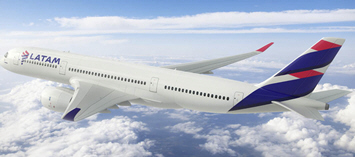

|
|
On August 13, 2010 Tam and Lan announced the start of
negotiations to form a giant in the Southern Hemisphere. The two largest
airlines in Latin America began a merger process creating LaTam - one of the
largest air carriers in the world. Following several industry mergers in the
USA and Europe, Latam was the first major merger in Latin America including
companies from different countries just as in Europe. Together, the
companies have millions of dollars in synergies, a strong presence in all
markets in South America and more strength to compete with the major USA and
European airlines. The two companies designed strategies for the merger to
comply with Brazilian law that limits the percentage that foreigners can
hold from a Brazilian airline (up to 20% at the time). Lan's attempt to
enter the Brazilian market was already old. Prior to Tam, Lan tried to
negotiate the purchase of Varig in 2006 and, since mid-2001, had controlled
ABSA Cargo. The Lan-Tam approach is also old: in 1996 the companies (along
with Taca) ordered 150 Airbus aircraft, for ordering together they would
have lower prices and could choose the delivery dates for the aircraft.
On January 19, 2011, the merger agreement was signed, but in June the
Chilean court halted the process to review the agreement. On September 21,
the Chilean court approved the merger with 11 conditions, including the
limit for tariff increases, allowing other companies to operate Santiago -
São Paulo route and that the companies could only remain in a global
alliance and could not be the same as Avianca-Taca group. On December 14,
2011, the Brazilian authorities also approved the merger with conditions
similar to those in Chile.
Finally on June 22, 2012, Latam was officially created. But in the same
month Avianca-Taca joined Star Alliance. Tam continued to be part of Star
Alliance, but did not make code-share agreement with Avianca-Taca, although
they were in the same alliance.
In December 2012, Tam and Lan Colombia announced a code-share agreement with
American Airlines, Lan's main partner in the USA. Finally on March 13, 2013,
Latam decided that Tam would leave Star Alliance and become part of OneWorld,
the alliance that Lan group was already part of.
Throughout 2013 year Latam's main concern was with Tam, who had huge losses,
while Lan group companies were good. As a consequence, Tam has reduced the
domestic capacity, increasing the aircraft load factor from 70% to 80%.
Another decision was concentrate international flights at Guarulhos
International Airport, so Tam's flights to Paris, Frankfurt and Montevideo
from Galeão International Airport were canceled. With respect to the fleet,
in 2013, Lan began replacing Boeing 767 with Boeing 787 while Tam, the
Airbus A330 by Boeing 767. Latam also received the first Airbus A320s
equipped with Sharklet, which reduce fuel consumption, and Increased orders
for Airbus A321 aircraft.
In November 2013 Latam inaugurated the first lounge room outside of South
America, at Miami Airport.
In 2014 Latam began to receive the A321 equipped with sharklet and the
Boeing 787-9. The group also announced a new aircraft interior design.
In March 2014 Tam finally joined OneWorld. Latam also announced new
international destinations for 2014/2015: Cancun, Toronto and Barcelona.
On August 6, 2015 the group announced that all the companies in the group
would call Latam. According to the group, in the long term a unique brand is
more efficient than investing in two brands around the world. Moreover for
the passenger it is confusing to understand that two brands are part of the
same group with the same service experience.
At the end of 2015 Latam announced several national and international
flights cuts in Brazil due to the economic crisis, including the end of
flights to Cancun. On December 18, Latam became the first airline in the
Southern Hemisphere to operate the A350.
In April 2016 LAN Pass and Tam Fidelidade loyalty programs were unified
under Latam Pass and Latam Fidelidade, respectively. On May 1, 2016, Latam
brand was finally launched, a Boeing 767-300 (ex-Tam) took off from Rio de
Janeiro to Geneva to bring the Olympic Torch for the games in Rio. The first
three commercial flights of Latam: São Paulo - Santiago (B767 ex-Tam),
Santiago - Lima (A319 ex-Lan) and São Paulo - Brasilia (A319 ex-Tam) took
off.
In July, 2016 Qatar Airways announced the purchase of 10% Latam's stake,
which further diluted Amaro family (former owners of Tam) ownership. In
August Latam Brazil became the first company in the Americas and the fifth
in the world to operate the Airbus A320neo.
In 2017 Latam announced the implementation of a new fare model in domestic
flights, based on low cost, low fare airlines. With the new model, Latam
expects to be able to offer up to 20% lower prices and hopes to increase
passenger volume up to 50% by 2020.
In February 2017 Latam Brasil leased four A350s to Qatar due to weak demand
in Brazil.
Founded: 2012
Main Airports: Guarulhos, Comodoro Arturo Merino Benítez, Jorge Chávez /
Callao, Mariscal Sucre, Ezeiza / Ministro Pistarini, El Dorado
Headquarters: Santiago, Chile
Current fleet: Airbus A319, Airbus A320, Airbus A320neo, Airbus A321,
Airbus A350-900, Boeing 767-300ER, Boeing 777-200F, Boeing 777-300ER,
Boeing 787-8, Boeing 787-9
Aircraft already operated: Airbus A318, Airbus A330-200, Airbus
A340-300, Airbus A340-500, Boeing 737-700, Bombardier Dash-8
Destinations (passengers): 144
Destinations (cargo): 152
Code-Share: OneWorld
> Fleet:
| E |
|
||||||||||||||||||||||||||||||
Updated 2017























